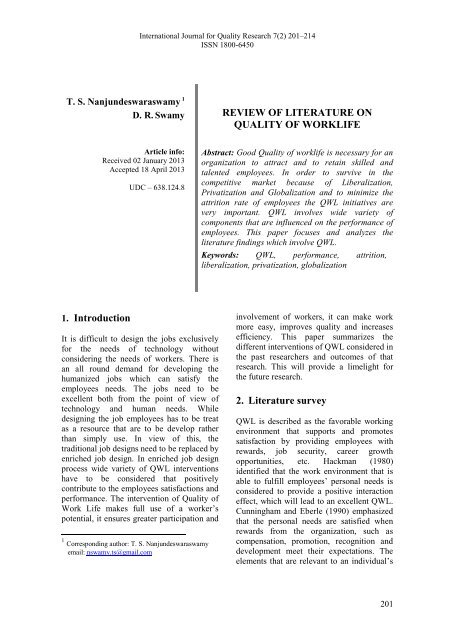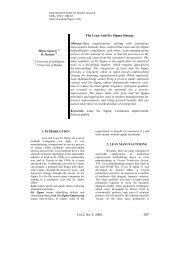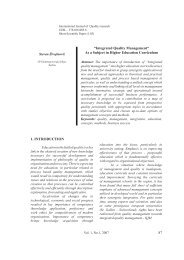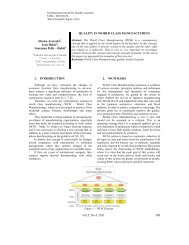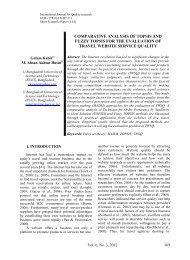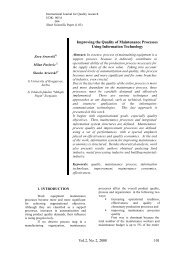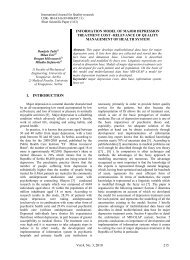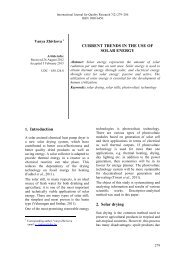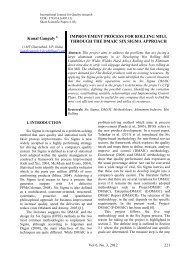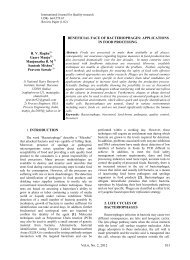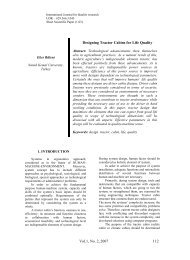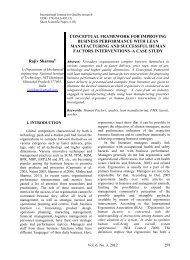review of literature on quality of worklife - International Journal of ...
review of literature on quality of worklife - International Journal of ...
review of literature on quality of worklife - International Journal of ...
You also want an ePaper? Increase the reach of your titles
YUMPU automatically turns print PDFs into web optimized ePapers that Google loves.
Internati<strong>on</strong>al <strong>Journal</strong> for Quality Research 7(2) 201–214<br />
ISSN 1800-6450<br />
T. S. Nanjundeswaraswamy 1<br />
D. R. Swamy<br />
REVIEW OF LITERATURE ON<br />
QUALITY OF WORKLIFE<br />
Article info:<br />
Received 02 January 2013<br />
Accepted 18 April 2013<br />
UDC – 638.124.8<br />
Abstract: Good Quality <str<strong>on</strong>g>of</str<strong>on</strong>g> <strong>worklife</strong> is necessary for an<br />
organizati<strong>on</strong> to attract and to retain skilled and<br />
talented employees. In order to survive in the<br />
competitive market because <str<strong>on</strong>g>of</str<strong>on</strong>g> Liberalizati<strong>on</strong>,<br />
Privatizati<strong>on</strong> and Globalizati<strong>on</strong> and to minimize the<br />
attriti<strong>on</strong> rate <str<strong>on</strong>g>of</str<strong>on</strong>g> employees the QWL initiatives are<br />
very important. QWL involves wide variety <str<strong>on</strong>g>of</str<strong>on</strong>g><br />
comp<strong>on</strong>ents that are influenced <strong>on</strong> the performance <str<strong>on</strong>g>of</str<strong>on</strong>g><br />
employees. This paper focuses and analyzes the<br />
<str<strong>on</strong>g>literature</str<strong>on</strong>g> findings which involve QWL.<br />
Keywords: QWL, performance, attriti<strong>on</strong>,<br />
liberalizati<strong>on</strong>, privatizati<strong>on</strong>, globalizati<strong>on</strong><br />
1. Introducti<strong>on</strong> 1<br />
It is difficult to design the jobs exclusively<br />
for the needs <str<strong>on</strong>g>of</str<strong>on</strong>g> technology without<br />
c<strong>on</strong>sidering the needs <str<strong>on</strong>g>of</str<strong>on</strong>g> workers. There is<br />
an all round demand for developing the<br />
humanized jobs which can satisfy the<br />
employees needs. The jobs need to be<br />
excellent both from the point <str<strong>on</strong>g>of</str<strong>on</strong>g> view <str<strong>on</strong>g>of</str<strong>on</strong>g><br />
technology and human needs. While<br />
designing the job employees has to be treat<br />
as a resource that are to be develop rather<br />
than simply use. In view <str<strong>on</strong>g>of</str<strong>on</strong>g> this, the<br />
traditi<strong>on</strong>al job designs need to be replaced by<br />
enriched job design. In enriched job design<br />
process wide variety <str<strong>on</strong>g>of</str<strong>on</strong>g> QWL interventi<strong>on</strong>s<br />
have to be c<strong>on</strong>sidered that positively<br />
c<strong>on</strong>tribute to the employees satisfacti<strong>on</strong>s and<br />
performance. The interventi<strong>on</strong> <str<strong>on</strong>g>of</str<strong>on</strong>g> Quality <str<strong>on</strong>g>of</str<strong>on</strong>g><br />
Work Life makes full use <str<strong>on</strong>g>of</str<strong>on</strong>g> a worker’s<br />
potential, it ensures greater participati<strong>on</strong> and<br />
1 Corresp<strong>on</strong>ding author: T. S. Nanjundeswaraswamy<br />
email: nswamy.ts@gmail.com<br />
involvement <str<strong>on</strong>g>of</str<strong>on</strong>g> workers, it can make work<br />
more easy, improves <strong>quality</strong> and increases<br />
efficiency. This paper summarizes the<br />
different interventi<strong>on</strong>s <str<strong>on</strong>g>of</str<strong>on</strong>g> QWL c<strong>on</strong>sidered in<br />
the past researchers and outcomes <str<strong>on</strong>g>of</str<strong>on</strong>g> that<br />
research. This will provide a limelight for<br />
the future research.<br />
2. Literature survey<br />
QWL is described as the favorable working<br />
envir<strong>on</strong>ment that supports and promotes<br />
satisfacti<strong>on</strong> by providing employees with<br />
rewards, job security, career growth<br />
opportunities, etc. Hackman (1980)<br />
identified that the work envir<strong>on</strong>ment that is<br />
able to fulfill employees’ pers<strong>on</strong>al needs is<br />
c<strong>on</strong>sidered to provide a positive interacti<strong>on</strong><br />
effect, which will lead to an excellent QWL.<br />
Cunningham and Eberle (1990) emphasized<br />
that the pers<strong>on</strong>al needs are satisfied when<br />
rewards from the organizati<strong>on</strong>, such as<br />
compensati<strong>on</strong>, promoti<strong>on</strong>, recogniti<strong>on</strong> and<br />
development meet their expectati<strong>on</strong>s. The<br />
elements that are relevant to an individual’s<br />
201
<strong>quality</strong> <str<strong>on</strong>g>of</str<strong>on</strong>g> work life include the task, the<br />
physical work envir<strong>on</strong>ment, social<br />
envir<strong>on</strong>ment within the organizati<strong>on</strong>,<br />
administrative system and relati<strong>on</strong>ship<br />
between life <strong>on</strong> and <str<strong>on</strong>g>of</str<strong>on</strong>g>f the job. Chan and<br />
Einstein (1990) explained QWL reflects as a<br />
c<strong>on</strong>cern for people’s experience at work,<br />
their relati<strong>on</strong>ship with other people, their<br />
work setting and their effectiveness <strong>on</strong> the<br />
job. European Foundati<strong>on</strong> for the<br />
Improvement <str<strong>on</strong>g>of</str<strong>on</strong>g> Living C<strong>on</strong>diti<strong>on</strong>s 2002<br />
described that the QWL is a multidimensi<strong>on</strong>al<br />
c<strong>on</strong>struct, made up <str<strong>on</strong>g>of</str<strong>on</strong>g> a number<br />
<str<strong>on</strong>g>of</str<strong>on</strong>g> interrelated factors that need careful<br />
c<strong>on</strong>siderati<strong>on</strong> to c<strong>on</strong>ceptualize and measure.<br />
It is associated with job satisfacti<strong>on</strong>, job<br />
involvement, motivati<strong>on</strong>, productivity,<br />
health, safety, job security, competence<br />
development and balance between work and<br />
n<strong>on</strong>-work life.<br />
Quality <str<strong>on</strong>g>of</str<strong>on</strong>g> work life is a process by which an<br />
organizati<strong>on</strong> resp<strong>on</strong>ds to employee needs for<br />
developing mechanisms to allow them to<br />
share fully in making the decisi<strong>on</strong>s that<br />
design their lives at work. Saraji and Dargahi<br />
(2006) study explained QWL as a<br />
comprehensive, department wide program<br />
designated to improve employee satisfacti<strong>on</strong>,<br />
strengthening workplace learning and<br />
helping employees had better manage,<br />
change and transiti<strong>on</strong> by c<strong>on</strong>ducting<br />
descriptive and analytical study. QWL<br />
programs will benefit both faculty and<br />
management, by mutually solving workrelated<br />
problems, building cooperati<strong>on</strong>,<br />
improving work envir<strong>on</strong>ments, restructuring<br />
tasks carefully and fairly managing human<br />
resource outcomes and pay<str<strong>on</strong>g>of</str<strong>on</strong>g>fs according to<br />
the study <str<strong>on</strong>g>of</str<strong>on</strong>g> Che Rose et al. (2006 A).<br />
Hosseini and Jorjatki (2010) c<strong>on</strong>cluded that<br />
the career satisfacti<strong>on</strong>, career achievement<br />
and career balance are not <strong>on</strong>ly the<br />
significant variables to achieve good <strong>quality</strong><br />
<str<strong>on</strong>g>of</str<strong>on</strong>g> work life but <strong>quality</strong> <str<strong>on</strong>g>of</str<strong>on</strong>g> work life (QWL)<br />
or the <strong>quality</strong> <str<strong>on</strong>g>of</str<strong>on</strong>g> work system as <strong>on</strong>e <str<strong>on</strong>g>of</str<strong>on</strong>g> the<br />
most interesting methods creating motivati<strong>on</strong><br />
and is a major way to have job enrichment.<br />
Which has its roots in staff and managers'<br />
attitude to motivati<strong>on</strong> category that is more<br />
attenti<strong>on</strong> to fair pay, growth opportunities<br />
and c<strong>on</strong>tinuing promoti<strong>on</strong> improves staff’s<br />
performance which in turn increases QWL<br />
<str<strong>on</strong>g>of</str<strong>on</strong>g> social insurance employees in Tehran.<br />
According to Rethinam (2008) QWL is a<br />
multi-dimensi<strong>on</strong>al c<strong>on</strong>struct, made up <str<strong>on</strong>g>of</str<strong>on</strong>g> a<br />
number <str<strong>on</strong>g>of</str<strong>on</strong>g> interrelated factors that need<br />
careful c<strong>on</strong>siderati<strong>on</strong> to c<strong>on</strong>ceptualize and<br />
measure. It is associated with job<br />
satisfacti<strong>on</strong>, job involvement, motivati<strong>on</strong>,<br />
productivity, health, safety and well-being,<br />
job security, competence development and<br />
balance between work and n<strong>on</strong> work life and<br />
also he c<strong>on</strong>cluded as QWL from the<br />
perspective <str<strong>on</strong>g>of</str<strong>on</strong>g> IT pr<str<strong>on</strong>g>of</str<strong>on</strong>g>essi<strong>on</strong>als is<br />
challenging both to the individuals and<br />
organizati<strong>on</strong>s.<br />
However, from the <str<strong>on</strong>g>literature</str<strong>on</strong>g> it can be<br />
summarized that QWL may be viewed as a<br />
wide-ranging c<strong>on</strong>cept, which includes<br />
satisfacti<strong>on</strong> towards work, participative<br />
management and improve work<br />
envir<strong>on</strong>ment. Table 1 lists the some <str<strong>on</strong>g>of</str<strong>on</strong>g> the<br />
comp<strong>on</strong>ents <str<strong>on</strong>g>of</str<strong>on</strong>g> QWL as c<strong>on</strong>sidered by the<br />
scholars in their studies al<strong>on</strong>g with the type<br />
<str<strong>on</strong>g>of</str<strong>on</strong>g> the sector and outcome.<br />
Table 1. Comp<strong>on</strong>ents <str<strong>on</strong>g>of</str<strong>on</strong>g> QWL In the view <str<strong>on</strong>g>of</str<strong>on</strong>g> different researchers al<strong>on</strong>g with the type <str<strong>on</strong>g>of</str<strong>on</strong>g><br />
industries.<br />
Author Comp<strong>on</strong>ent Type <str<strong>on</strong>g>of</str<strong>on</strong>g> the Out comes<br />
Industries<br />
Walt<strong>on</strong> 1. Adequate And Fair Compensati<strong>on</strong>, Service All these<br />
(1975) 2. Safe And Healthy Working industries comp<strong>on</strong>ents<br />
USA<br />
C<strong>on</strong>diti<strong>on</strong>s,<br />
are the<br />
3. Immediate Opportunity To Use And<br />
Develop Human<br />
associated with<br />
QWL<br />
202
Levine,<br />
Taylor and<br />
Davis (1984)<br />
Europe<br />
Mirvis and<br />
Lawler<br />
(1984)<br />
UK<br />
Baba and<br />
Jamal (1991)<br />
UK<br />
Lau and<br />
Bruce (1998)<br />
US<br />
Ellis and<br />
Pompli<br />
(2002)<br />
Canberra<br />
4. Capacities,<br />
5. Opportunity For C<strong>on</strong>tinued Growth<br />
And Security,<br />
6. Social Integrati<strong>on</strong> In The Work<br />
Organizati<strong>on</strong>,<br />
7. C<strong>on</strong>stituti<strong>on</strong>alism In The Work<br />
Organizati<strong>on</strong>,<br />
8. Work And Total Life Space And<br />
9. Social Relevance Of Work Life.<br />
1. Respect from supervisor and trust <strong>on</strong><br />
employee’s capability;<br />
2. Change <str<strong>on</strong>g>of</str<strong>on</strong>g> work;<br />
3. Challenge <str<strong>on</strong>g>of</str<strong>on</strong>g> the work;<br />
4. Future development opportunity<br />
arising from the current<br />
5. work;<br />
6. Self esteem;<br />
7. Scope <str<strong>on</strong>g>of</str<strong>on</strong>g> impacted work and life<br />
bey<strong>on</strong>d work itself;<br />
8. C<strong>on</strong>tributi<strong>on</strong> towards society from the<br />
work<br />
1. Safe work envir<strong>on</strong>ment,<br />
2. Equitable wages,<br />
3. Equal employment opportunities and<br />
4. Opportunities for advancement<br />
1. Job satisfacti<strong>on</strong>,<br />
2. Job involvement,<br />
3. Work role ambiguity,<br />
4. Work role c<strong>on</strong>flict,<br />
5. Work role overload,<br />
6. Job stress,<br />
7. Organizati<strong>on</strong>al commitment and<br />
8. Turn-over intenti<strong>on</strong>s<br />
1. Job security<br />
2. Reward systems<br />
3. Training<br />
4. Carrier advancements opportunities<br />
5. Participati<strong>on</strong> in decisi<strong>on</strong> in decisi<strong>on</strong><br />
making<br />
1. Poor working envir<strong>on</strong>ments,<br />
2. Resident aggressi<strong>on</strong>,<br />
3. Workload, inability to deliver <strong>quality</strong><br />
<str<strong>on</strong>g>of</str<strong>on</strong>g> care preferred,<br />
4. Balance <str<strong>on</strong>g>of</str<strong>on</strong>g> work and family,<br />
Insurance<br />
Company<br />
Corporati<strong>on</strong><br />
service<br />
Nurses in<br />
Hospital<br />
Manufacturing<br />
industries<br />
Nurses in<br />
Hospital<br />
QWL Policies<br />
may vary as<br />
per the size <str<strong>on</strong>g>of</str<strong>on</strong>g><br />
the<br />
organizati<strong>on</strong><br />
and employees<br />
group<br />
QWL was<br />
associated with<br />
satisfacti<strong>on</strong>,<br />
wages, hours<br />
and working<br />
c<strong>on</strong>diti<strong>on</strong><br />
M<strong>on</strong>ot<strong>on</strong>y in<br />
the job due to<br />
routine work<br />
activities can<br />
affect QWL<br />
Negatively<br />
QWL is<br />
workplace<br />
strategies ,<br />
operati<strong>on</strong>s and<br />
envir<strong>on</strong>ment<br />
that promote<br />
and maintain<br />
employees<br />
satisfacti<strong>on</strong><br />
All these<br />
factors<br />
associated with<br />
Job<br />
dissatisfacti<strong>on</strong><br />
203
Thomas A.<br />
Wyatt &<br />
Chay Yue<br />
Wah (2001)<br />
Singaporean<br />
Guna Seelan<br />
Rethinam<br />
& Maimunah<br />
Ismail<br />
(2008)<br />
Malaysia<br />
Hosseini<br />
(2010)<br />
Raduan Che<br />
Rose<br />
(2006 B)<br />
5. Shift work,<br />
6. Lack <str<strong>on</strong>g>of</str<strong>on</strong>g> involvement in decisi<strong>on</strong><br />
making,<br />
7. Pr<str<strong>on</strong>g>of</str<strong>on</strong>g>essi<strong>on</strong>al isolati<strong>on</strong>,<br />
8. Lack <str<strong>on</strong>g>of</str<strong>on</strong>g> recogniti<strong>on</strong>,<br />
9. Poor relati<strong>on</strong>ships with<br />
supervisor/peers,<br />
10. Role c<strong>on</strong>flict,<br />
11. Lack <str<strong>on</strong>g>of</str<strong>on</strong>g> opportunity to learn new skills.<br />
1. Favorable work envir<strong>on</strong>ment,<br />
2. Pers<strong>on</strong>al growth and aut<strong>on</strong>omy<br />
3. Nature <str<strong>on</strong>g>of</str<strong>on</strong>g> job,<br />
4. Stimulating opportunities and coworkers.<br />
1. 1 Health and well-being<br />
2. 2 Job security<br />
3. 3 Job satisfacti<strong>on</strong>,<br />
4. 4 Competence development and<br />
5. 5 The balance between work n<strong>on</strong> work<br />
life<br />
1. Adequate And Fair Compensati<strong>on</strong>,<br />
2. Safe And Healthy Working<br />
C<strong>on</strong>diti<strong>on</strong>s,<br />
3. Immediate Opportunity To Use And<br />
Develop Human<br />
4. Capacities,<br />
5. Opportunity For C<strong>on</strong>tinued Growth<br />
And Security,<br />
6. Social Integrati<strong>on</strong> In The Work<br />
Organizati<strong>on</strong>,<br />
7. C<strong>on</strong>stituti<strong>on</strong>alism In The Work<br />
Organizati<strong>on</strong>,<br />
8. Work And Total Life Space And<br />
9. Social Relevance Of Work Life.<br />
1. Career satisfacti<strong>on</strong><br />
2. Career achievement<br />
3. Career balance<br />
All type <str<strong>on</strong>g>of</str<strong>on</strong>g><br />
industries<br />
Informati<strong>on</strong><br />
technology<br />
(IT)<br />
pr<str<strong>on</strong>g>of</str<strong>on</strong>g>essi<strong>on</strong>als<br />
Insurance<br />
workers <str<strong>on</strong>g>of</str<strong>on</strong>g><br />
Mazandaran<br />
province<br />
Managers<br />
from the<br />
free trade<br />
and QWL<br />
All these<br />
comp<strong>on</strong>ents<br />
are associated<br />
with the<br />
<strong>quality</strong> <str<strong>on</strong>g>of</str<strong>on</strong>g><br />
<strong>worklife</strong> <str<strong>on</strong>g>of</str<strong>on</strong>g><br />
Employees<br />
All these<br />
comp<strong>on</strong>ents<br />
are associated<br />
with the<br />
<strong>quality</strong> <str<strong>on</strong>g>of</str<strong>on</strong>g><br />
<strong>worklife</strong> <str<strong>on</strong>g>of</str<strong>on</strong>g> IT<br />
Employees<br />
Results have<br />
shown that<br />
am<strong>on</strong>g the<br />
eight<br />
dimensi<strong>on</strong>s <str<strong>on</strong>g>of</str<strong>on</strong>g><br />
<strong>quality</strong> <str<strong>on</strong>g>of</str<strong>on</strong>g><br />
<strong>worklife</strong> , pay<br />
fair and<br />
adequate pay<br />
size,<br />
Integrati<strong>on</strong> and<br />
social<br />
cohesi<strong>on</strong>,<br />
growth<br />
opportunities,<br />
c<strong>on</strong>tinuing<br />
security, the<br />
integrati<strong>on</strong> and<br />
development<br />
<str<strong>on</strong>g>of</str<strong>on</strong>g> human<br />
Capabilities<br />
are related to<br />
performance.<br />
The result<br />
indicates that<br />
three<br />
204
Malayasis<br />
G Nasl<br />
Saraji,<br />
H Dargahi<br />
(2006)<br />
Tehran<br />
Saklani,<br />
D.R., 1979<br />
India<br />
Stephen, A.<br />
(2012).<br />
India<br />
1. Fair Pay and Aut<strong>on</strong>omy<br />
2. Job security,<br />
3. Reward systems,<br />
4. Training and career advancements<br />
5. Opportunities,<br />
6. Participati<strong>on</strong> in decisi<strong>on</strong> making<br />
7. Interesting and satisfying work.<br />
8. Trust in senior management.<br />
9. Recogniti<strong>on</strong> <str<strong>on</strong>g>of</str<strong>on</strong>g> efforts<br />
10. Health and safety standards at work.<br />
11. Balance between the time spent at<br />
work and the time spent with family<br />
and friends<br />
12. Amount <str<strong>on</strong>g>of</str<strong>on</strong>g> work to be d<strong>on</strong>e<br />
13. Level <str<strong>on</strong>g>of</str<strong>on</strong>g> stress experienced at work<br />
14. Occupati<strong>on</strong>al health and safety at work<br />
1. Adequate and fair compensati<strong>on</strong><br />
2. Fringe benefits and welfare measures<br />
3. Job security<br />
4. Physical work envir<strong>on</strong>ment<br />
5. Work load and job stress<br />
6. Opportunity to use and develop human<br />
capacity<br />
7. Opportunity for c<strong>on</strong>tinued growth<br />
8. Human relati<strong>on</strong>s and social aspect <str<strong>on</strong>g>of</str<strong>on</strong>g><br />
work life<br />
9. Participati<strong>on</strong> in decisi<strong>on</strong> making<br />
10. Reward and penalty system<br />
11. Equity, justice and grievance handling<br />
12. Work and total life space<br />
13. Image <str<strong>on</strong>g>of</str<strong>on</strong>g> organizati<strong>on</strong><br />
1. Adequate and fair compensati<strong>on</strong><br />
2. Fringe benefits and welfare measures<br />
3. Job security<br />
z<strong>on</strong>es in<br />
Malaysia for<br />
both the<br />
multinati<strong>on</strong>al<br />
corporati<strong>on</strong>s<br />
(MNCs) and<br />
the smallmedium<br />
industries<br />
(SMIs)<br />
Tehran<br />
University <str<strong>on</strong>g>of</str<strong>on</strong>g><br />
Medical<br />
Sciences<br />
(TUMS)<br />
Hospitals’<br />
employees<br />
The sample<br />
comprised<br />
resp<strong>on</strong>dents <str<strong>on</strong>g>of</str<strong>on</strong>g><br />
both<br />
managerial<br />
and n<strong>on</strong>managerial<br />
categories<br />
drawn from 24<br />
organizati<strong>on</strong>s<br />
<str<strong>on</strong>g>of</str<strong>on</strong>g><br />
different<br />
types.<br />
Employers<br />
and<br />
employees <str<strong>on</strong>g>of</str<strong>on</strong>g><br />
exogenous<br />
variables are<br />
significant:<br />
career<br />
satisfacti<strong>on</strong>,<br />
career<br />
achievement<br />
and career<br />
balance, with<br />
63% <str<strong>on</strong>g>of</str<strong>on</strong>g> the<br />
variance in<br />
QWL<br />
The results<br />
showed that<br />
the majority <str<strong>on</strong>g>of</str<strong>on</strong>g><br />
employees<br />
were<br />
dissatisfied<br />
with<br />
occupati<strong>on</strong>al<br />
health and<br />
safety,<br />
intermediate<br />
and senior<br />
managers ,<br />
their income,<br />
balance<br />
between the<br />
time they spent<br />
working and<br />
with family<br />
Apart from<br />
m<strong>on</strong>etary<br />
c<strong>on</strong>siderati<strong>on</strong>s,<br />
employees in<br />
India accord a<br />
high value to<br />
the factors that<br />
satisfy selfesteem<br />
and<br />
selfactualizati<strong>on</strong><br />
needs <str<strong>on</strong>g>of</str<strong>on</strong>g><br />
a higher order.<br />
The findings <str<strong>on</strong>g>of</str<strong>on</strong>g><br />
the study<br />
regarding<br />
205
Muftah, H.<br />
A., & Lafi,<br />
H. (2011)<br />
4. Physical work envir<strong>on</strong>ment<br />
5. Work load and job stress<br />
6. Opportunity to use and develop human<br />
capacity<br />
7. Opportunity for c<strong>on</strong>tinued growth<br />
8. Human relati<strong>on</strong>s and social aspect <str<strong>on</strong>g>of</str<strong>on</strong>g><br />
work life<br />
9. Participati<strong>on</strong> in decisi<strong>on</strong> making<br />
10. Reward and penalty system<br />
11. Equity, justice and grievance handling<br />
12. Work and total life space<br />
13. Image <str<strong>on</strong>g>of</str<strong>on</strong>g> organizati<strong>on</strong><br />
1. Physical,<br />
2. Psychological<br />
3. Social factors<br />
various Small<br />
scale<br />
industrial<br />
units in<br />
Chennai,<br />
Coimbatore<br />
and Madurai<br />
cities in Tamil<br />
Nadu, India<br />
employees<br />
working in the<br />
Oil<br />
and Gas<br />
companies in<br />
the State <str<strong>on</strong>g>of</str<strong>on</strong>g><br />
Qatar<br />
percepti<strong>on</strong> <str<strong>on</strong>g>of</str<strong>on</strong>g><br />
employers and<br />
employees <strong>on</strong><br />
QWL<br />
variables,<br />
revealed ten<br />
important<br />
QWL factors<br />
in SSI These<br />
are social<br />
support,<br />
interpers<strong>on</strong>al<br />
relati<strong>on</strong>ship,<br />
Recogniti<strong>on</strong>,<br />
aut<strong>on</strong>omy,<br />
working<br />
envir<strong>on</strong>ment,<br />
relati<strong>on</strong>ship<br />
with boss,<br />
working hours,<br />
governance by<br />
rule <str<strong>on</strong>g>of</str<strong>on</strong>g> law,<br />
role clarity and<br />
fringe benefits.<br />
The result <str<strong>on</strong>g>of</str<strong>on</strong>g><br />
this study<br />
supports that<br />
the most<br />
important<br />
determinant <str<strong>on</strong>g>of</str<strong>on</strong>g><br />
QWL is<br />
physical<br />
factors,<br />
followed by<br />
psychological<br />
factors and<br />
then social<br />
factors.<br />
The study<br />
indicated that<br />
QWL is<br />
positively and<br />
significantly<br />
related to<br />
employee<br />
satisfacti<strong>on</strong>.<br />
206
3. Comp<strong>on</strong>ents <str<strong>on</strong>g>of</str<strong>on</strong>g> <strong>quality</strong> <str<strong>on</strong>g>of</str<strong>on</strong>g><br />
<strong>worklife</strong><br />
The elements that are relevant to an<br />
individual’s <strong>quality</strong> <str<strong>on</strong>g>of</str<strong>on</strong>g> work life include the<br />
task, the physical work envir<strong>on</strong>ment, social<br />
envir<strong>on</strong>ment within the organizati<strong>on</strong>,<br />
administrative system and relati<strong>on</strong>ship<br />
between life <strong>on</strong> and <str<strong>on</strong>g>of</str<strong>on</strong>g>f the job (Cunningham<br />
and Eberle, 1990).<br />
QWL is a multi-dimensi<strong>on</strong>al c<strong>on</strong>struct, made<br />
up <str<strong>on</strong>g>of</str<strong>on</strong>g> a number <str<strong>on</strong>g>of</str<strong>on</strong>g> interrelated factors that<br />
need careful c<strong>on</strong>siderati<strong>on</strong> to c<strong>on</strong>ceptualize<br />
and measure. It is associated with job<br />
satisfacti<strong>on</strong>, job involvement, motivati<strong>on</strong>,<br />
productivity, health, safety and well-being,<br />
job security, competence development and<br />
balance between work and n<strong>on</strong>-work life as<br />
is c<strong>on</strong>ceptualized by European Foundati<strong>on</strong><br />
for the Improvement <str<strong>on</strong>g>of</str<strong>on</strong>g> Living C<strong>on</strong>diti<strong>on</strong>s<br />
(European Foundati<strong>on</strong> for the Improvement<br />
<str<strong>on</strong>g>of</str<strong>on</strong>g> Living C<strong>on</strong>diti<strong>on</strong>s, 2002).<br />
Rethinam (2008) and Serey (2006) explained<br />
QWL is quite c<strong>on</strong>clusive and best meet the<br />
c<strong>on</strong>temporary work envir<strong>on</strong>ment. The<br />
definiti<strong>on</strong> was related to meaningful and<br />
satisfying work. It includes (i) an<br />
opportunity to exercise <strong>on</strong>e’s talents and<br />
capacities, to face challenges and situati<strong>on</strong>s<br />
that require independent initiative and selfdirecti<strong>on</strong>,<br />
(ii) an activity thought to be<br />
worthwhile by the individuals involved, (iii)<br />
an activity in which <strong>on</strong>e understands the role<br />
the individual plays in the achievement <str<strong>on</strong>g>of</str<strong>on</strong>g><br />
some overall goals, and (iv) a sense <str<strong>on</strong>g>of</str<strong>on</strong>g> taking<br />
pride in what <strong>on</strong>e is doing and in doing it<br />
well. This issue <str<strong>on</strong>g>of</str<strong>on</strong>g> meaningful and satisfying<br />
work is <str<strong>on</strong>g>of</str<strong>on</strong>g>ten merged with discussi<strong>on</strong>s <str<strong>on</strong>g>of</str<strong>on</strong>g> job<br />
satisfacti<strong>on</strong>, and believed to be more<br />
favorable to QWL.<br />
Lau and Bruce (1998) explained QWL is a<br />
dynamic multidimensi<strong>on</strong>al c<strong>on</strong>struct that<br />
currently includes such c<strong>on</strong>cepts as job<br />
security, reward systems, training and career<br />
advancements opportunities, and<br />
participati<strong>on</strong> decisi<strong>on</strong> making. According to<br />
Kalra and Ghosh (1984) studies suggest that,<br />
in the Indian c<strong>on</strong>text, envir<strong>on</strong>mental factors<br />
like physical envir<strong>on</strong>ment, safety and other<br />
working c<strong>on</strong>diti<strong>on</strong>s and relati<strong>on</strong>al factors<br />
like work group relati<strong>on</strong>s, and labourmanagement<br />
relati<strong>on</strong>s are more important<br />
with regard to QWL<br />
From the <str<strong>on</strong>g>literature</str<strong>on</strong>g> survey, following 9<br />
important comp<strong>on</strong>ents <str<strong>on</strong>g>of</str<strong>on</strong>g> <strong>quality</strong> <str<strong>on</strong>g>of</str<strong>on</strong>g> work life<br />
were c<strong>on</strong>sidered for the <str<strong>on</strong>g>literature</str<strong>on</strong>g> <str<strong>on</strong>g>review</str<strong>on</strong>g>.<br />
1. Work envir<strong>on</strong>ment<br />
2. Organizati<strong>on</strong> culture and climate<br />
3. Relati<strong>on</strong> and co-operati<strong>on</strong><br />
4. Training and development<br />
5. Compensati<strong>on</strong> and Rewards<br />
6. Facilities<br />
7. Job satisfacti<strong>on</strong> and Job security<br />
8. Aut<strong>on</strong>omy <str<strong>on</strong>g>of</str<strong>on</strong>g> work<br />
9. Adequacy <str<strong>on</strong>g>of</str<strong>on</strong>g> resources<br />
3.1 Work Envir<strong>on</strong>ment<br />
Working envir<strong>on</strong>ment is a place that <strong>on</strong>e<br />
works. It is a social and pr<str<strong>on</strong>g>of</str<strong>on</strong>g>essi<strong>on</strong>al<br />
envir<strong>on</strong>ment in which employees are<br />
supposed to interact with a number <str<strong>on</strong>g>of</str<strong>on</strong>g><br />
people, and have to work with co ordinati<strong>on</strong><br />
in <strong>on</strong>e or the other way. Safe and healthy<br />
working c<strong>on</strong>diti<strong>on</strong>s ensure good health,<br />
c<strong>on</strong>tinuity <str<strong>on</strong>g>of</str<strong>on</strong>g> services, decreased bad labour<br />
management relati<strong>on</strong>s. A healthy worker<br />
registers a high productivity. Employees are<br />
cheerful, c<strong>on</strong>fident and may prove an<br />
invaluable asset to the organizati<strong>on</strong>. It<br />
c<strong>on</strong>sists <str<strong>on</strong>g>of</str<strong>on</strong>g> safe physical and mental working<br />
situati<strong>on</strong>s and determining logical working<br />
hours.<br />
Lau et al. (2001) explained QWL as the<br />
favorable working envir<strong>on</strong>ment that supports<br />
and promotes satisfacti<strong>on</strong> by providing<br />
employees with rewards, job security and<br />
career growth opportunities. According to<br />
Winter et al. (2000) QWL for academicians<br />
as an attitudinal resp<strong>on</strong>se to the prevailing<br />
work envir<strong>on</strong>ment and posited five work<br />
envir<strong>on</strong>ment domains that include role<br />
stress, job characteristics, supervisory,<br />
structural and sect oral characteristics to<br />
directly and indirectly shape academicians<br />
experiences, attitudes and behavior.<br />
207
The elements that are relevant to an<br />
individual’s <strong>quality</strong> <str<strong>on</strong>g>of</str<strong>on</strong>g> work life include the<br />
task, the physical work envir<strong>on</strong>ment, social<br />
envir<strong>on</strong>ment within the organizati<strong>on</strong>,<br />
administrative system and relati<strong>on</strong>ship<br />
between life <strong>on</strong> and <str<strong>on</strong>g>of</str<strong>on</strong>g>f the job Cunningham<br />
and Eberle (1990). According to Kirkman<br />
(1989) QWL is an integrated improvement<br />
plan to improve working envir<strong>on</strong>ment and<br />
satisfy the employee’s individual needs.<br />
Hackman and Oldham (1980) Suggested<br />
that the work envir<strong>on</strong>ment that is able to<br />
fulfill employees’ pers<strong>on</strong>al needs such as<br />
skill variety, task identity, task significance,<br />
aut<strong>on</strong>omy and feedback, is c<strong>on</strong>sidered to<br />
provide a positive interacti<strong>on</strong> effect, which<br />
will lead to an excellent QWL.<br />
3.2 Organizati<strong>on</strong> Culture and Climate<br />
Organizati<strong>on</strong> culture is a set <str<strong>on</strong>g>of</str<strong>on</strong>g> properties<br />
and organizati<strong>on</strong> climate is a collective<br />
behaviour <str<strong>on</strong>g>of</str<strong>on</strong>g> people that are part <str<strong>on</strong>g>of</str<strong>on</strong>g> an<br />
organizati<strong>on</strong> values, visi<strong>on</strong>, norms etc.<br />
Promoti<strong>on</strong> opportunities, promoti<strong>on</strong> and<br />
reward evaluati<strong>on</strong> criteria used are both<br />
under the direct c<strong>on</strong>trol <str<strong>on</strong>g>of</str<strong>on</strong>g> an organizati<strong>on</strong><br />
and subject to the organizati<strong>on</strong>'s policies. If<br />
these two elements are found to have<br />
significant effects <strong>on</strong> outcomes such as<br />
Quality <str<strong>on</strong>g>of</str<strong>on</strong>g> Work Life, organizati<strong>on</strong>al<br />
commitment, job satisfacti<strong>on</strong> and turnover<br />
intent then that direct c<strong>on</strong>trol permits their<br />
alterati<strong>on</strong> as necessary to produce a positive<br />
impact <strong>on</strong> those outcomes.<br />
Certo (2004) study shows that <strong>quality</strong> <str<strong>on</strong>g>of</str<strong>on</strong>g><br />
work life is the degree <str<strong>on</strong>g>of</str<strong>on</strong>g> opportunity <str<strong>on</strong>g>of</str<strong>on</strong>g><br />
workers to make decisi<strong>on</strong>s that influence<br />
their work situati<strong>on</strong>. The greater the<br />
opportunity <str<strong>on</strong>g>of</str<strong>on</strong>g> workers to make such<br />
decisi<strong>on</strong>s, the higher the <strong>quality</strong> <str<strong>on</strong>g>of</str<strong>on</strong>g> work life.<br />
According to Cavry (1995) Organizati<strong>on</strong>al<br />
features such as policies and procedures,<br />
leadership style, operati<strong>on</strong>s, and general<br />
c<strong>on</strong>textual factors <str<strong>on</strong>g>of</str<strong>on</strong>g> setting, all have a<br />
pr<str<strong>on</strong>g>of</str<strong>on</strong>g>ound effect <strong>on</strong> how staff views the<br />
<strong>quality</strong> <str<strong>on</strong>g>of</str<strong>on</strong>g> work life<br />
3.3 Relati<strong>on</strong> and Co-Operati<strong>on</strong><br />
Relati<strong>on</strong> and co operati<strong>on</strong> is a<br />
communicati<strong>on</strong> between management and<br />
employees, c<strong>on</strong>cerning workplace decisi<strong>on</strong>,<br />
c<strong>on</strong>flicts and problem resolving. Work and<br />
career are typically pursued within the<br />
framework <str<strong>on</strong>g>of</str<strong>on</strong>g> social organizati<strong>on</strong> and the<br />
nature <str<strong>on</strong>g>of</str<strong>on</strong>g> pers<strong>on</strong>al relati<strong>on</strong>ships becomes an<br />
important dimensi<strong>on</strong> <str<strong>on</strong>g>of</str<strong>on</strong>g> Quality <str<strong>on</strong>g>of</str<strong>on</strong>g> Work<br />
Life. Acceptance <str<strong>on</strong>g>of</str<strong>on</strong>g> the worker is based <strong>on</strong><br />
work related traits, skills, abilities and<br />
potential without regard to race, sex,<br />
physical appearance etc. Social coherent in<br />
the work organizati<strong>on</strong>, sense <str<strong>on</strong>g>of</str<strong>on</strong>g> bel<strong>on</strong>ging to<br />
the organizati<strong>on</strong>.<br />
According to Che Rose, Raduan., Beh,<br />
LooSee., Uli, Jegak., and Idris, Khairuddin<br />
(2006 B) study QWL is associated with<br />
career development and career is evolving<br />
from such interacti<strong>on</strong> <str<strong>on</strong>g>of</str<strong>on</strong>g> individuals within<br />
the organizati<strong>on</strong>s. Robbins et al (2002),<br />
Bandura et al. (1988) in their study they<br />
explained Human care can also increase<br />
staff’s self-c<strong>on</strong>fidence and self-efficacy, and<br />
actively overcome the difficulties.<br />
3.4 Training and Development<br />
Training and development is a organizati<strong>on</strong>al<br />
activity aimed at bettering the performance<br />
<str<strong>on</strong>g>of</str<strong>on</strong>g> individual and groups. Quality <str<strong>on</strong>g>of</str<strong>on</strong>g> Work<br />
Life is ensured by the opportunities provided<br />
by the job for the development <str<strong>on</strong>g>of</str<strong>on</strong>g> the<br />
employee and encouragement given by the<br />
management to perform the job. Having<br />
good c<strong>on</strong>diti<strong>on</strong>s to increase pers<strong>on</strong>al<br />
empowerment and skills.<br />
Skrovan (1983) and American Society for<br />
Training and Development ( ASTD) defined<br />
the QWL as a process for the working<br />
organizati<strong>on</strong>, which enables the employees<br />
at each hierarchy to actively participate in<br />
building the organizati<strong>on</strong> envir<strong>on</strong>ment,<br />
developing organizati<strong>on</strong>al model so as to<br />
produce the organizati<strong>on</strong>al achievements.<br />
This process is based <strong>on</strong> the two goals<br />
together 1) To improve organizati<strong>on</strong>al<br />
208
efficiency and 2) To improve the <strong>quality</strong> <str<strong>on</strong>g>of</str<strong>on</strong>g><br />
working life.<br />
3.5 Compensati<strong>on</strong> and Rewards<br />
Compensati<strong>on</strong> and rewards are motivati<strong>on</strong>al<br />
factors, the best performer is given the<br />
rewards, and this builds the competiti<strong>on</strong>s<br />
am<strong>on</strong>g the employees to work hard and to<br />
achieve both organizati<strong>on</strong>al and individual<br />
goals. The ec<strong>on</strong>omic interests <str<strong>on</strong>g>of</str<strong>on</strong>g> people<br />
drive them to work at a job and employee<br />
satisfacti<strong>on</strong> depends at least partially, <strong>on</strong> the<br />
compensati<strong>on</strong> <str<strong>on</strong>g>of</str<strong>on</strong>g>fered. Pay should be fixed<br />
<strong>on</strong> the basis <str<strong>on</strong>g>of</str<strong>on</strong>g> the work d<strong>on</strong>e,<br />
resp<strong>on</strong>sibilities undertaken, individual skills,<br />
performance and accomplishments. Mirvis<br />
and Lawler (1984) highlighted that Quality<br />
<str<strong>on</strong>g>of</str<strong>on</strong>g> working life was associated with<br />
satisfacti<strong>on</strong> with wages, hours and working<br />
c<strong>on</strong>diti<strong>on</strong>s, describing the “basic elements <str<strong>on</strong>g>of</str<strong>on</strong>g><br />
a good <strong>quality</strong> <str<strong>on</strong>g>of</str<strong>on</strong>g> work life” as; safe work<br />
envir<strong>on</strong>ment, equitable wages, equal<br />
employment opportunities and opportunities<br />
for advancement. Oshagbemi, Sloane and<br />
Williams, who highlighted differences in<br />
remunerati<strong>on</strong> aspects received by the<br />
employee will suddenly affect their work<br />
satisfacti<strong>on</strong> and work performance. Drobnic<br />
et al. (2010) suggest that employees that<br />
have secured jobs and pay would feel<br />
comfortable at the work place and this<br />
affects their <strong>quality</strong> <str<strong>on</strong>g>of</str<strong>on</strong>g> life. Meeting socially<br />
determined needs and fair compensati<strong>on</strong> can<br />
create an appropriate work envir<strong>on</strong>ment<br />
(Weisboard, 2007). According to Saraji and<br />
Dargahi (2006) the Nursing Work life<br />
Satisfacti<strong>on</strong> survey results showed that Pay<br />
and Aut<strong>on</strong>omy were the two most important<br />
comp<strong>on</strong>ents <str<strong>on</strong>g>of</str<strong>on</strong>g> nurses’ <strong>quality</strong> <str<strong>on</strong>g>of</str<strong>on</strong>g> work life.<br />
3.6 Facilities<br />
Facilities play major role in actualizati<strong>on</strong> <str<strong>on</strong>g>of</str<strong>on</strong>g><br />
the goals and objectives by satisfying the<br />
both physical and emoti<strong>on</strong>al needs <str<strong>on</strong>g>of</str<strong>on</strong>g> the<br />
employees. Facilities are like food service,<br />
transportati<strong>on</strong>, security etc. Many employers<br />
have found it beneficial to allow alternate<br />
work arrangements for their employees. This<br />
is <strong>on</strong>e way to improve employee<br />
productivity and morale. The advantages <str<strong>on</strong>g>of</str<strong>on</strong>g><br />
these alternate work arrangements to the<br />
employee include flexible work hours,<br />
shorter or no commute, and a comfortable<br />
working envir<strong>on</strong>ment.<br />
3.7 Job Satisfacti<strong>on</strong> & Job security<br />
Job satisfacti<strong>on</strong> is the favorableness or un<br />
favorableness with which employees view<br />
their work. As with motivati<strong>on</strong>, it is affected<br />
by the envir<strong>on</strong>ment. Job satisfacti<strong>on</strong> is<br />
impacted by job design. Jobs that are rich in<br />
positive behavioral elements – such as<br />
aut<strong>on</strong>omy, variety, task identity, task<br />
significance and feedback c<strong>on</strong>tribute to<br />
employees’ satisfacti<strong>on</strong>. Sayeed and Sinha<br />
(1980) examined the relati<strong>on</strong>ship between<br />
QWL, job stress and performance. The<br />
results indicate that higher QWL leads to<br />
greater job satisfacti<strong>on</strong>. Lashbrook (1997)<br />
study found that leadership style plays a vital<br />
role in influencing employees’ job<br />
satisfacti<strong>on</strong>. According to Bogler (2002),<br />
different leadership styles will stimulate<br />
different working envir<strong>on</strong>ment and directly<br />
affect the job satisfacti<strong>on</strong> <str<strong>on</strong>g>of</str<strong>on</strong>g> the employees.<br />
Wats<strong>on</strong> et al. (2003) studies indicate that<br />
many different aspects <str<strong>on</strong>g>of</str<strong>on</strong>g> the job, such as<br />
pay, promoti<strong>on</strong>s, supervisi<strong>on</strong>, fringe<br />
benefits, <strong>on</strong>e’s co-workers support, and<br />
excessive working hours are associated with<br />
levels <str<strong>on</strong>g>of</str<strong>on</strong>g> satisfacti<strong>on</strong>.<br />
Pelsma et al. (1989) found that<br />
psychological distress and morale<br />
c<strong>on</strong>tributed equally to teachers QWL. They<br />
determined that in the work climate <str<strong>on</strong>g>of</str<strong>on</strong>g> an<br />
occupati<strong>on</strong>, QWL can be assessed by<br />
combining the amount and the degree <str<strong>on</strong>g>of</str<strong>on</strong>g><br />
stress and the degree <str<strong>on</strong>g>of</str<strong>on</strong>g> satisfacti<strong>on</strong><br />
experienced by the individual within his/her<br />
occupati<strong>on</strong>al role. Noor and Abdullah (2012)<br />
and Ko<strong>on</strong>mee et al. (2010) study indicate<br />
that there is a significant relati<strong>on</strong>ship<br />
between job satisfacti<strong>on</strong> and <strong>quality</strong> <str<strong>on</strong>g>of</str<strong>on</strong>g> work<br />
209
life. Job satisfacti<strong>on</strong> is found to carry more<br />
weightage in explaining the relati<strong>on</strong>ship<br />
am<strong>on</strong>g job satisfacti<strong>on</strong>, job involvement and<br />
job security with <strong>quality</strong> <str<strong>on</strong>g>of</str<strong>on</strong>g> work life.<br />
Job security<br />
Employees want stability <str<strong>on</strong>g>of</str<strong>on</strong>g> employment,<br />
they do not like to be the victims <str<strong>on</strong>g>of</str<strong>on</strong>g><br />
whimsical pers<strong>on</strong>al policies and stay at the<br />
mercy <str<strong>on</strong>g>of</str<strong>on</strong>g> employers. Job security is another<br />
factor that is <str<strong>on</strong>g>of</str<strong>on</strong>g> c<strong>on</strong>cern to employees.<br />
Permanent employment provides security to<br />
the employees and improves their QWL. A<br />
dramatic change <str<strong>on</strong>g>of</str<strong>on</strong>g> workforce in<br />
c<strong>on</strong>temporary work envir<strong>on</strong>ment has<br />
revealed a significant amount organizati<strong>on</strong><br />
change (Wats<strong>on</strong> et al. 2003).organizati<strong>on</strong><br />
change such as downsizing, rightsizing and<br />
outsourcing have adversely affected<br />
employees’ loyalty, morale, motivati<strong>on</strong> and<br />
perceived job security. Organizati<strong>on</strong> <str<strong>on</strong>g>of</str<strong>on</strong>g><br />
Ec<strong>on</strong>omic Cooperati<strong>on</strong> and Development<br />
(1996) survey highlighted that job security<br />
is the most c<strong>on</strong>troversial issue in<br />
c<strong>on</strong>temporary work envir<strong>on</strong>ment. Job<br />
security, the central aspect <str<strong>on</strong>g>of</str<strong>on</strong>g> QWL<br />
represents strength <str<strong>on</strong>g>of</str<strong>on</strong>g> the organizati<strong>on</strong>s to<br />
provide permanent and stable employment<br />
regardless <str<strong>on</strong>g>of</str<strong>on</strong>g> the changes in work<br />
envir<strong>on</strong>ment. Drobnic et al. (2010) suggest<br />
that employees that have secured jobs and<br />
pay would feel comfortable at the work place<br />
and this affects their <strong>quality</strong> <str<strong>on</strong>g>of</str<strong>on</strong>g> life.<br />
3.8 Aut<strong>on</strong>omy <str<strong>on</strong>g>of</str<strong>on</strong>g> Work<br />
In aut<strong>on</strong>omous work groups, employees are<br />
given the freedom <str<strong>on</strong>g>of</str<strong>on</strong>g> decisi<strong>on</strong> making,<br />
workers themselves plan, coordinate and<br />
c<strong>on</strong>trol work related activities It also<br />
includes different opportunities for pers<strong>on</strong>nel<br />
such as independency at work and having the<br />
authority to access the related informati<strong>on</strong><br />
for their task. Robins (1989) suggests that<br />
QWL is a process by which an organizati<strong>on</strong><br />
resp<strong>on</strong>ds to employee needs by developing<br />
mechanisms to allow them to share fully in<br />
making the decisi<strong>on</strong>s that design their lives<br />
at work. According to Scully et al. (1995)<br />
greater aut<strong>on</strong>omy <strong>on</strong> job enhances the<br />
acquisiti<strong>on</strong> and utilizati<strong>on</strong> <str<strong>on</strong>g>of</str<strong>on</strong>g> knowledge<br />
whilst greater participati<strong>on</strong> is held to<br />
promote cognitive growth via increased<br />
knowledge transfer am<strong>on</strong>g employees.<br />
Feuer (1989) and Che Rose et al. (2006)<br />
explained people also c<strong>on</strong>ceive <str<strong>on</strong>g>of</str<strong>on</strong>g> QWL as a<br />
set <str<strong>on</strong>g>of</str<strong>on</strong>g> methods, such as aut<strong>on</strong>omous work<br />
groups, job enrichment and highinvolvement<br />
aimed at boosting the<br />
satisfacti<strong>on</strong> and productivity <str<strong>on</strong>g>of</str<strong>on</strong>g> workers.<br />
Rethinam (2008) study highlights, If the<br />
organizati<strong>on</strong> provides the appropriate<br />
authority to design work activities to the<br />
individual employees, then it is highly<br />
possible that the work activities can match<br />
their employees needs that c<strong>on</strong>tribute to the<br />
organizati<strong>on</strong>al performance.<br />
According to Speitzer et al. (1997) study<br />
Staff’s perceived significance <str<strong>on</strong>g>of</str<strong>on</strong>g> work and<br />
decisi<strong>on</strong>-making power in psychological<br />
empowerment can improve satisfacti<strong>on</strong> and<br />
eliminate tensi<strong>on</strong>. Saraji and Dargahi (2006)<br />
explained the Nursing Work life Satisfacti<strong>on</strong><br />
survey results showed that Pay and<br />
Aut<strong>on</strong>omy were the two most important<br />
comp<strong>on</strong>ents <str<strong>on</strong>g>of</str<strong>on</strong>g> nurses’ <strong>quality</strong> <str<strong>on</strong>g>of</str<strong>on</strong>g> work life.<br />
3.9 Adequacy <str<strong>on</strong>g>of</str<strong>on</strong>g> Resources<br />
Resources should match with stated<br />
objectives; otherwise, employees will not be<br />
able to attain the Objectives. This results in<br />
employee dissatisfacti<strong>on</strong> and lower QWL.<br />
According to Chelte (1983) adequacy <str<strong>on</strong>g>of</str<strong>on</strong>g><br />
resources has to do with enough time and<br />
equipment, adequate informati<strong>on</strong> and help to<br />
complete assignments.<br />
4. C<strong>on</strong>clusi<strong>on</strong><br />
Literatures <str<strong>on</strong>g>review</str<strong>on</strong>g>ed have shown that QWL<br />
is a multidimensi<strong>on</strong>al c<strong>on</strong>structs, these<br />
c<strong>on</strong>structs have to be c<strong>on</strong>sider during the job<br />
design process. The <str<strong>on</strong>g>literature</str<strong>on</strong>g> would also<br />
revel the c<strong>on</strong>tributi<strong>on</strong> <str<strong>on</strong>g>of</str<strong>on</strong>g> the nine important<br />
210
comp<strong>on</strong>ents <str<strong>on</strong>g>of</str<strong>on</strong>g> QWL which positively<br />
associated with the employee satisfacti<strong>on</strong><br />
and employees opini<strong>on</strong> <strong>on</strong> QWL in different<br />
sectors. In the view <str<strong>on</strong>g>of</str<strong>on</strong>g> the <str<strong>on</strong>g>review</str<strong>on</strong>g> <str<strong>on</strong>g>of</str<strong>on</strong>g><br />
<str<strong>on</strong>g>literature</str<strong>on</strong>g>, in Indian c<strong>on</strong>text have limited<br />
<str<strong>on</strong>g>literature</str<strong>on</strong>g> and studies <strong>on</strong> QWL especially in<br />
the SMEs. Indian SMEs facing a high<br />
attriti<strong>on</strong> rate problem, to find out the root<br />
cause, a study may be undertaken by<br />
c<strong>on</strong>sidering the important nine comp<strong>on</strong>ents<br />
in Indian SMEs.<br />
References:<br />
Bandura, A. (1988). Organizati<strong>on</strong>al applicati<strong>on</strong>s <str<strong>on</strong>g>of</str<strong>on</strong>g> social cognitive theory. Australian journal<br />
<str<strong>on</strong>g>of</str<strong>on</strong>g> management,13(2), 275-302.<br />
Bogler, R. (2002). Two pr<str<strong>on</strong>g>of</str<strong>on</strong>g>iles <str<strong>on</strong>g>of</str<strong>on</strong>g> schoolteachers: A discriminate analysis <str<strong>on</strong>g>of</str<strong>on</strong>g> job satisfacti<strong>on</strong>.<br />
Teaching and Teacher Educati<strong>on</strong>, 18(6), 665-673.<br />
Cavry, J., Wakefield, D., Price, I., Mueller, C., & Mcloskey, J. (1995). Determinants <str<strong>on</strong>g>of</str<strong>on</strong>g><br />
turnover am<strong>on</strong>g nursing department employees. Res Nurs Health, 8, 397-411.<br />
Certo, S. C. (2004). Modern Management: <strong>quality</strong>, Ethics and the Global Envir<strong>on</strong>ment.<br />
Bost<strong>on</strong>: Allyn and Bac<strong>on</strong>.<br />
Chan, C. H., & Einstein, W. O. (1990). Quality <str<strong>on</strong>g>of</str<strong>on</strong>g> Work Life (QWL): What canuni<strong>on</strong>s do?<br />
SAM Advanced Management J., 55, 17-22.<br />
Che Rose, R., & Beh, L. S., Uli, J., & Idris, K. (2006 A). An Analysis <str<strong>on</strong>g>of</str<strong>on</strong>g> Quality <str<strong>on</strong>g>of</str<strong>on</strong>g> Work Life<br />
(QWL) and Career- Related Variables. American <strong>Journal</strong> <str<strong>on</strong>g>of</str<strong>on</strong>g> Applied Sciences, 3(12), 2151-<br />
2159.<br />
Che Rose, R., & Beh, L. S., Uli, J., & Idris, K. (2006 B). Quality <str<strong>on</strong>g>of</str<strong>on</strong>g> work life: Implicati<strong>on</strong>s <str<strong>on</strong>g>of</str<strong>on</strong>g><br />
career dimensi<strong>on</strong>s. <strong>Journal</strong> <str<strong>on</strong>g>of</str<strong>on</strong>g> Social Sciences, 2(2), 61-67.<br />
Chelte, A. F. (1983). Organizati<strong>on</strong>al commitment, job satisfacti<strong>on</strong> and <strong>quality</strong> <str<strong>on</strong>g>of</str<strong>on</strong>g> <strong>worklife</strong>.<br />
U.M.I. Dissertati<strong>on</strong> informati<strong>on</strong> service<br />
Cunningham, J. B., & Eberle, T. (1990). A guide to job enrichment and redesign. Pers<strong>on</strong>nel,<br />
67(2), 56-61.<br />
Drobnic, S., Behan, B., & Prag, P. (2010). Good job, good life? Working c<strong>on</strong>diti<strong>on</strong>s and<br />
<strong>quality</strong> <str<strong>on</strong>g>of</str<strong>on</strong>g> life in Europe. Social Indicators Research, 99(2), 205-225.<br />
Ellis, N., & Pompli, A. (2002). Quality <str<strong>on</strong>g>of</str<strong>on</strong>g> working life for nurses. Comm<strong>on</strong>wealth Dept <str<strong>on</strong>g>of</str<strong>on</strong>g><br />
Health and Ageing. Canberra.<br />
European Foundati<strong>on</strong> for the Improvement <str<strong>on</strong>g>of</str<strong>on</strong>g> Living C<strong>on</strong>diti<strong>on</strong>s. (2002). New Work<br />
organizati<strong>on</strong>, working c<strong>on</strong>diti<strong>on</strong>s and <strong>quality</strong> <str<strong>on</strong>g>of</str<strong>on</strong>g> work: towards the flexible firm? [Online]<br />
European Foundati<strong>on</strong> for the Improvement <str<strong>on</strong>g>of</str<strong>on</strong>g> Living and Working C<strong>on</strong>diti<strong>on</strong>. Luxembourg:<br />
Office for <str<strong>on</strong>g>of</str<strong>on</strong>g>ficial publicati<strong>on</strong>s <str<strong>on</strong>g>of</str<strong>on</strong>g> the European Communities: Ireland .Available:<br />
www.eur<str<strong>on</strong>g>of</str<strong>on</strong>g>ound.eu.int.<br />
Feuer, D. (1989). Quality <str<strong>on</strong>g>of</str<strong>on</strong>g> work life: a cure for all ills? Training: The Magazine <str<strong>on</strong>g>of</str<strong>on</strong>g> Human<br />
Resources Development, 26, 65-66.<br />
Hackman, J. R., & Oldham, G. R. (1980). Work redesign, Redesigns. M.A: Addis<strong>on</strong>- Wesley.<br />
Hosseini, S. M. (2010). Quality <str<strong>on</strong>g>of</str<strong>on</strong>g> work life (QWL) and its relati<strong>on</strong>ship with performance.<br />
Advanced Management Science, 1, 559-562.<br />
Kalra, S. K., & Ghosh, S. (1984). Quality <str<strong>on</strong>g>of</str<strong>on</strong>g> work life: A study <str<strong>on</strong>g>of</str<strong>on</strong>g> associated factors. The<br />
Indian <strong>Journal</strong> <str<strong>on</strong>g>of</str<strong>on</strong>g> Social Work, 25(3), 341-349.<br />
211
Kirkman, F. (1989). The <strong>quality</strong> <str<strong>on</strong>g>of</str<strong>on</strong>g> working life, robotics and the pr<str<strong>on</strong>g>of</str<strong>on</strong>g>essi<strong>on</strong>al engineer.<br />
Management Decisi<strong>on</strong>, 27(4), 48-54.<br />
Ko<strong>on</strong>mee, K., Singhapakdi, A., Virakul, B., & Lee, D.-J. (2010). Ethics instituti<strong>on</strong>alizati<strong>on</strong>,<br />
<strong>quality</strong> <str<strong>on</strong>g>of</str<strong>on</strong>g> work life and employees jobrelated outcomes: A survey <str<strong>on</strong>g>of</str<strong>on</strong>g> human resoure<br />
managers in Thailand. <strong>Journal</strong> <str<strong>on</strong>g>of</str<strong>on</strong>g> Business Research, 63, 20-26.<br />
Lau, R. S. M., & Bruce, E. M. (1998). A win-win paradigm for <strong>quality</strong> <str<strong>on</strong>g>of</str<strong>on</strong>g> work life and<br />
business performance. Human Resource Development Quarterly, 9(3), 211-26.<br />
Lau, T., W<strong>on</strong>g, Y. H., Chan, K. F., & Law, M. (2001). Informati<strong>on</strong> technology and the work<br />
envir<strong>on</strong>ment-does it change the way people interact at work. Human Systems Management,<br />
20(3), 267-280.<br />
Mirvis, P. H., & Lawler, E. E. (1984). Accounting for the Quality <str<strong>on</strong>g>of</str<strong>on</strong>g> Work Life. <strong>Journal</strong> <str<strong>on</strong>g>of</str<strong>on</strong>g><br />
Occupati<strong>on</strong>al Behaviour, 5, 197-212.<br />
Noor, S. M., & Abdullah, M. A. (2012). Quality Work Life am<strong>on</strong>g Factory Workers in<br />
Malaysia. Procedia - Social and Behavioral Sciences, 35, 739-745.<br />
Organisati<strong>on</strong> <str<strong>on</strong>g>of</str<strong>on</strong>g> Ec<strong>on</strong>omic Cooperati<strong>on</strong> and Development, 1996. “Technology,<br />
Pelsma, D. M., Richard, G. V., Harringt<strong>on</strong>, R. G., & Burry, J. M. (1989). The <strong>quality</strong> <str<strong>on</strong>g>of</str<strong>on</strong>g> teacher<br />
work life survey: A measure <str<strong>on</strong>g>of</str<strong>on</strong>g> teacher stress and job satisfacti<strong>on</strong>. Measurement and<br />
Evaluati<strong>on</strong> in Counselling and Development, 21, 165-76.<br />
Rethinam, G. S. (2008). C<strong>on</strong>structs <str<strong>on</strong>g>of</str<strong>on</strong>g> Quality <str<strong>on</strong>g>of</str<strong>on</strong>g> Work Life: A Perspective <str<strong>on</strong>g>of</str<strong>on</strong>g> Informati<strong>on</strong> and<br />
Technology Pr<str<strong>on</strong>g>of</str<strong>on</strong>g>essi<strong>on</strong>als. European <strong>Journal</strong> <str<strong>on</strong>g>of</str<strong>on</strong>g> Social Sciences, 7(1), 58-70.<br />
Rethinam, G. S., & Ismail, M. (2008). C<strong>on</strong>structs <str<strong>on</strong>g>of</str<strong>on</strong>g> Quality <str<strong>on</strong>g>of</str<strong>on</strong>g> Work Life: A Perspective <str<strong>on</strong>g>of</str<strong>on</strong>g><br />
Informati<strong>on</strong> and Technology pr<str<strong>on</strong>g>of</str<strong>on</strong>g>essi<strong>on</strong>als. European <strong>Journal</strong> <str<strong>on</strong>g>of</str<strong>on</strong>g> Social Sciences, 7, 58-70.<br />
Robbins, T. L., Crino, M. D., & Fredendall, L. D. (2002). An integrative model <str<strong>on</strong>g>of</str<strong>on</strong>g> the<br />
empowerment process. Human Resources Management Review, 12, 419-443.<br />
Robins, S. P. (1989). Organizati<strong>on</strong>al Behavior: C<strong>on</strong>cepts, C<strong>on</strong>troversies, and Applicati<strong>on</strong>s.<br />
New Jersey: Prentice Hall.<br />
Saraji, G. N., Dargahi, H. (2006). Study <str<strong>on</strong>g>of</str<strong>on</strong>g> Quality <str<strong>on</strong>g>of</str<strong>on</strong>g> Work Life (QWL). Iranian <strong>Journal</strong> <str<strong>on</strong>g>of</str<strong>on</strong>g><br />
Public Health, 35(4), 8-14.<br />
Scully, J., Kirkpatrick, A., & Locke, E. (1995). Locus <str<strong>on</strong>g>of</str<strong>on</strong>g> Knowledge as a Determinati<strong>on</strong> <str<strong>on</strong>g>of</str<strong>on</strong>g> the<br />
Effects <str<strong>on</strong>g>of</str<strong>on</strong>g> Participati<strong>on</strong> <strong>on</strong> Performance, Affect, and Percepti<strong>on</strong>s. Organisati<strong>on</strong>al Behaviour<br />
Human Decisi<strong>on</strong> Making Process, 61, 276288.<br />
Serey, T. T. (2006). Choosing a robust <strong>quality</strong> <str<strong>on</strong>g>of</str<strong>on</strong>g> work life. Business Forum, 27(2), 7-10.<br />
Skrovan, D. J. (1983). Quality <str<strong>on</strong>g>of</str<strong>on</strong>g> work life persectives for business and the public sector.<br />
L<strong>on</strong>d<strong>on</strong>: Addis<strong>on</strong>-Wesley.<br />
Speitzer, G. M., Kizilos, M. A., & Nas<strong>on</strong>, S. W. A dimensi<strong>on</strong>al analysis <str<strong>on</strong>g>of</str<strong>on</strong>g> the relati<strong>on</strong>ship<br />
between psychological empowerment and effectiveness, satisfacti<strong>on</strong>, and strain. <strong>Journal</strong> <str<strong>on</strong>g>of</str<strong>on</strong>g><br />
Management, 2(33), 679-704.<br />
Walt<strong>on</strong>, R. E. (1975). Criteria for Quality <str<strong>on</strong>g>of</str<strong>on</strong>g> Working Life’ in Davis, L. & Cherns, A. (eds)<br />
(1975) The Quality <str<strong>on</strong>g>of</str<strong>on</strong>g> Working Life Vol 1, Free Press, New York, 91-10.<br />
Wats<strong>on</strong>, I., Buchanan, J., Campbell, I., & Briggs, C. (2003). Fragmented Futures: New<br />
Challenges in Working Life. Sydney, New South Wales: The Federati<strong>on</strong> Press.<br />
Weisboard, M. R. (2007). Productive Workplace: Organizing and Managing for Dignity,<br />
Meaning and Community, 5 th editi<strong>on</strong>, San Francisco, CA: Jossey Bass.<br />
212
Winter, R., Taylor, T., & Sarros, J. (2000). Trouble at mill: <strong>quality</strong> <str<strong>on</strong>g>of</str<strong>on</strong>g> academic work life<br />
issues within a comprehensive Australian university. Studies in Higher Educati<strong>on</strong>, 25, 279-<br />
94.<br />
Wyatt, T. A., & Wah, C. Y. (2001). Percepti<strong>on</strong>s <str<strong>on</strong>g>of</str<strong>on</strong>g> QWL: A study <str<strong>on</strong>g>of</str<strong>on</strong>g> Singaporean Employees<br />
Development. Research and Practice in Human Resource Management, 9(2), 59-76.<br />
T S<br />
Nanjundeswaraswamy<br />
Department <str<strong>on</strong>g>of</str<strong>on</strong>g> Industrial<br />
Engineering & Management<br />
JSS Academy <str<strong>on</strong>g>of</str<strong>on</strong>g> Technical<br />
Educati<strong>on</strong>,<br />
Bangalore<br />
nswamy.ts@gmail.com<br />
Swamy D R<br />
Department <str<strong>on</strong>g>of</str<strong>on</strong>g> Industrial<br />
Engineering & Management<br />
JSS Academy <str<strong>on</strong>g>of</str<strong>on</strong>g> Technical<br />
Educati<strong>on</strong>,<br />
Bangalore<br />
drswamydr@gmail.com<br />
213
214


